Islands in the Stream: Self-Guided Tour of Paris Ile-de-la-Cite
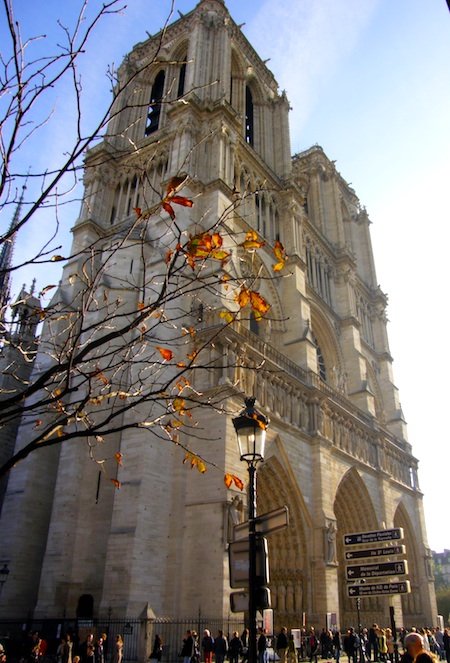
- SUBSCRIBE
- ALREADY SUBSCRIBED?
BECOME A BONJOUR PARIS MEMBER
Gain full access to our collection of over 5,000 articles and bring the City of Light into your life. Just 80 USD per year.
Find out why you should become a member here.
Sign in
Fill in your credentials below.
Notre-Dame Cathedral plaza. Photo by Paul Prescott.
The Seine is a beautiful necklace strewn across Paris’s slender neck and each of the islands set in the stream sparkles like a diamond, adding éclat to the City of Light.
Île-de-la-Cité
The Île-de-la-Cité is not just the center of Paris, it is also, quite literally, the center of France: embedded in the square in front of the Notre-Dame Cathedral is a disk marking “Kilometer Zero,” the place from which all road distances are calculated in the country. The island is also probably the cradle of the city itself, as a Gallic river people known as the Parisii settled here in 52 BC and would later provide inspiration for the city’s name.
The Île, however, is more than just a historical footnote punctuating the Seine. It’s a fascinating self-enclosed promenade that encapsulates all of Paris into one compact walk.
Vert Galant
On the Pont Neuf (or “New Bridge” which, in classic French irony, is the oldest bridge in Paris) stands the proud equestrian statue of Henri IV. On either side of the statue, staircases lead the explorer down to the Square du Vert-Galant, a park on the westernmost tip of the île. The green area takes its name from Henry IV’s nickname, le vert gallant, which was literary slang referring to an elderly man with many lovers. Many smaller islands were combined to form this space and one of them, l’île aux Juifs, was where the last Knights Templar were burned at the stake. At the base of the stairs leading back up to the bridge, a plaque commemorates the immolation of Jacques de Molay, last Grand Master of the Knights Templar, on March 18, 1314, who was burned at approximately this place.
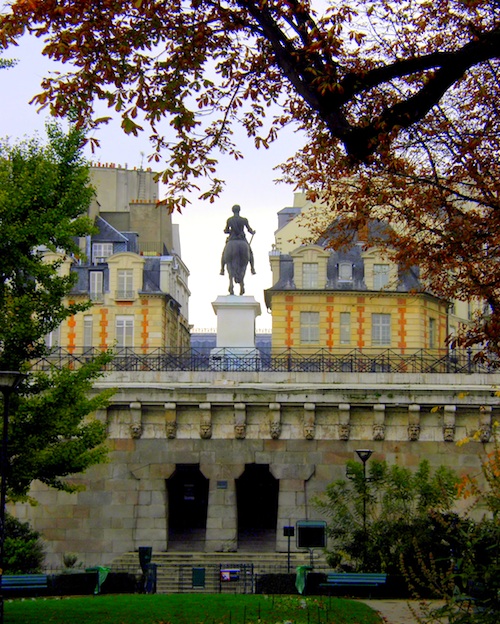
Henri IV statue at Pont Neuf. Photo by Paul Prescott.
Place Dauphine
Follow Henry IV’s static indications to where he’s pointing, across the street and between the buildings, into the Place Dauphine. The triangular “square” remains one of those picture-postcard places so quintessentially Paris, a haven of calm in the bustle of the Île-de-la-Cité.
Flower Market
Continue your stroll eastward, around the imposing Palais de Justice until you arrive at the Place Louis Lépine. This wide-open cement vista offers a view of the Palais de Justice imprisoned behind its gilded gates and beside it, the iron spires of the Sainte-Chapelle. At the other end of the vast plaza is the art nouveau Métro entrance for the Cité station, designed by architect Hector Guimard in 1900.
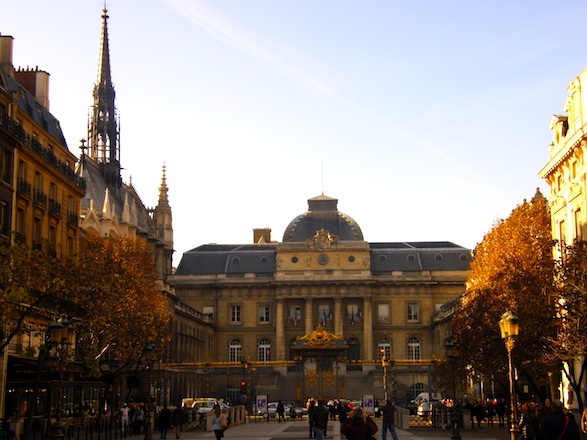
Place Louis Lépine and Palais de Justice. Photo by Paul Prescott.
Just beyond the sinuous curves of the metalwork is the Marché aux Fleurs. This daily flower market blossoms here like an eternal spring day and on Sundays even molts into a bird market. In addition to a forest of flora, the bouquinistes set up shop along the wall overlooking the Seine and this can be a good place to find postcards, art prints and even books, as their name seems to suggest.
Héloïse et Abélard
Follow the curve of the island up along the Quai aux Fleurs until you reach numbers 9 – 11. Looking up you’ll notice you’re being watched by two tragic figures in the history of romance. It was in this building that Pierre Abélard came as a tutor for Héloïse d’Argenteuil. As a relatively young and rebellious philosopher, Abélard was like a rock star of his day and Héloïse one of the most intelligent women in Paris, not to mention one of the most beautiful. After convincing her uncle to allow Abélard to tutor her, they fell in love despite her being 20 years his junior. When the uncle found out, Abélard had to leave, only to learn that Héloïse was pregnant. Following the birth of their son, Astrolabe, they were married in secret before giving their child up to Héloïse’s sister and separating forever, he becoming a monk and escaping into his books, she running to the convent where she would finish her days writing him passionate letters of love.
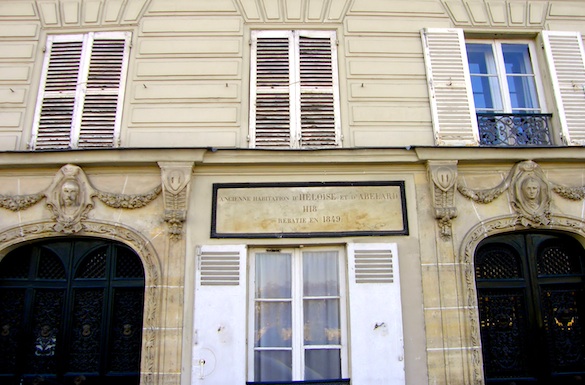
Héloïse et Abélard plaque at 9-11, quai aux Fleurs. Photo by Paul Prescott.
Mémorial des Martyrs de la Déportation
Just as poignant, though for other reasons, is the Memorial to the Martyrs of the Deportation. Tucked away on the easternmost tip of the island, our tour ends much as it began, with another descent down a staircase, although the destination here is no simple park but a white stone enclosure guarded by two mysterious monoliths. The tight passages, narrow staircases, and spiked gates symbolize the Nazi camps where the members of the Resistance, homosexuals, social misfits, Jehovah’s Witnesses, enemies of the Nazi Party, Jews, Slavs, Gypsies and the handicapped were sent to work and, for many, die.
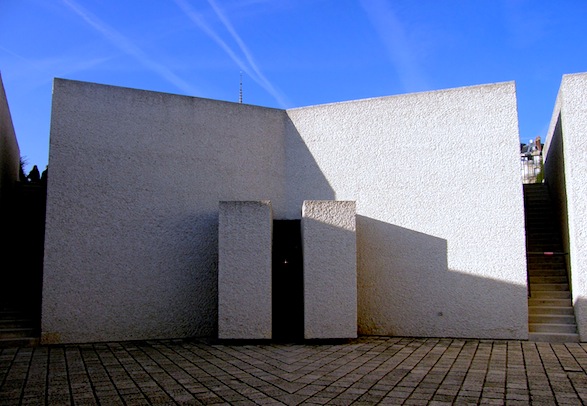
Mémorial des Martyrs de la Déportation. Photo by Paul Prescott.
Sliding between large blocks of stone, the visitor enters a dim chamber with smaller alcoves that represent the main camps to which the victims were deported, each containing earth and ashes collected at the respective site. Set into the floor in the center of the gallery is a disc which rests on the ashes of an unknown victim to the Nazis. Beyond this, 200,000 lit crystals represent each of the French deportees who never returned.
A moving termination to our promenade that led us down paths less traveled to reveal a side most visitors never take the time to see.
PRACTICAL INFORMATION:
Arrondissement-by-arrondissement guide to Paris sightseeing destinations
Online route maps for Paris Métro, RER, bus, SNCF (Transilien)
Vélib’ bike rental station maps
Text and story photos ©Paul Prescott. (Intro photo, Métro: Cité, ©DaliParis)
 Paul Prescott is a Paris-based writer and he also blogs at Paris Inspired website. Please click on his name to read his profile and links to other stories by Paul published by BonjourParis.
Paul Prescott is a Paris-based writer and he also blogs at Paris Inspired website. Please click on his name to read his profile and links to other stories by Paul published by BonjourParis.



